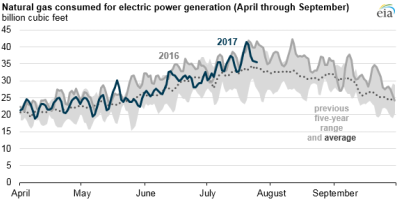EIA: Natgas-fired electricity generation this summer below last year’s level
The amount of natural gas used for electricity generation, also known as power burn, reached its highest daily level so far in 2017 during the past week, exceeding 41 Bcf on July 20, according to data from PointLogic Energy. Natural gas-fired electricity generation typically peaks at the end of July or the beginning of August because of high demand for air conditioning during that period. Power burn reached a record daily high on Aug. 11, 2016, surpassing 42 Bcf.
 |
| Courtesy of EIA. |
Power burn from April 1 through July 25 averaged 27.1 Bcfd, or 7% lower than last year’s consumption over the same period. Although power burn in 2017 is lower than in 2016, it is still relatively high compared with the previous five-year average for that period.
Higher natural gas prices relative to last summer explain part of the decrease. The Henry Hub natural gas spot price averaged $2.27/MMBtu from April 1, 2016, through July 25, 2016, compared with $3.03/MMBtu during the same period in 2017. Average natural gas prices at power plants were $1.02/MMBtu higher in the first half of 2017 compared with the first half of 2016, while coal prices were about the same in the first half of both years.
Coal and natural gas generated 30% and 34% of US electricity in 2016, respectively—the first year that natural gas-fired electricity generation exceeded coal-fired generation. EIA’s most recent Electric Power Monthly data show that coal provided 30% of utility-scale US electricity generation over the first four months of 2017, while natural gas provided 28%. EIA’s most recent Short-Term Energy Outlook expects that for 2017 as a whole, natural gas and coal will each generate 31% of the electricity in the United States.
For 2017 as a whole, EIA forecasts that power burn will average 25.9 Bcfd, 2.5 Bcfd (9%) lower than in 2016. Overall electricity generation is expected to be slightly lower than the 2016 level, and natural gas’s share declines because of larger shares from renewable sources (particularly hydropower) and coal-fired generation.

- ADNOC Gas awards $2.1 B in contracts to enhance LNG supply infrastructure
- U.S. Department of the Treasury releases final rules for clean hydrogen production tax credit
- Nicor Gas celebrates its first renewable natural gas interconnection
- EnviTec Biogas looks to expand biogas production into the U.S.
- Phillips 66 outlines nearly $3-B capital program for 2025



Comments